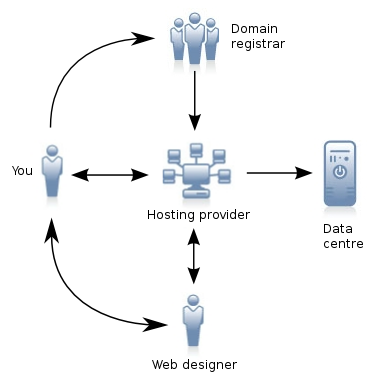Typical Web Hosting Arrangements
Abstract: This is a brief introduction to typical web hosting arrangements likely to be encountered by a small business or consumer. It is targeted towards readers who are not computer experts and the content is non-technical in nature.
If you are interested in getting a website for your first (or even second) time, you may find that you have to deal with a number of different parties, all playing their part in getting your website up and running. It can be a bit bewildering trying to sort out who's who and who's doing what, so hopefully this article will help you navigate it all.
Having a conscientious web designer or a consultant working on your behalf can insulate you from this, but sometimes it helps to understand the arrangments behind it all. Who knows, maybe you might have to change one of your providers?
Unless you're a big multinational with an IT department that does everything themselves, you're likely to encounter an arrangement similar to the following:

The Parties

You
That's you!
Domain Registrar
This company registers your domain name for you with the relevant Internet authorities.
Registering a domain name is a very early step in getting a website. A domain name is usually the last two or three words of a web address, after the 'www'. So, for example, google.com is a domain name, and so is yahoo.com.au.
Hosting Provider
This company hosts your website. In other words, your website is stored on one of their server computers.
Data Centre
This company houses the server that hosts your website. In other words, your website is physically located at their premises.

So, what's the difference between a hosting provider and a data centre? Usually, either the hosting provider is reselling the data centre's servers (so the data centre is the hosting provider's hosting provider, if you follow), or the hosting provider leases space at the data centre to locate their own servers. You can also think of data centres as wholesalers while hosting providers are retailers. Sometimes, the hosting provider also happens to be the data centre operator.
Data centres are secure, well guarded buildings designed to protect the thousands of computers located inside. They often have redundant power supplies or backup generators and all sorts of other fancy facilities. Some are even located underground to withstand environmental shocks.
Data centres are large and expensive to operate, so there aren't that many around. Instead, many hosting providers will utilise the space at one data centre through some sort of commercial wholesale arrangement.
If your hosting provider is a small or local business, chances are that their servers are in a data centre somewhere else in the country.
Web Designer
This is the person or company who designs and implements your website.
After designing your website, the designer usually copies the website over to the hosting provider, so you will probably have to give them your username and password.
Multiple Roles
While there are four external parties listed above, some companies will play multiple roles. For example, most hosting providers resell domain registration services, data centres can also be retail hosting providers (but not necessarily vice versa), and your website may be designed by someone who provides hosting as part of a package.

So there you have it! Web hosting arrangments demystified! In practice, there are variations on the generic scenario presented, but at least now, it's (hopefully) making a bit more sense.
